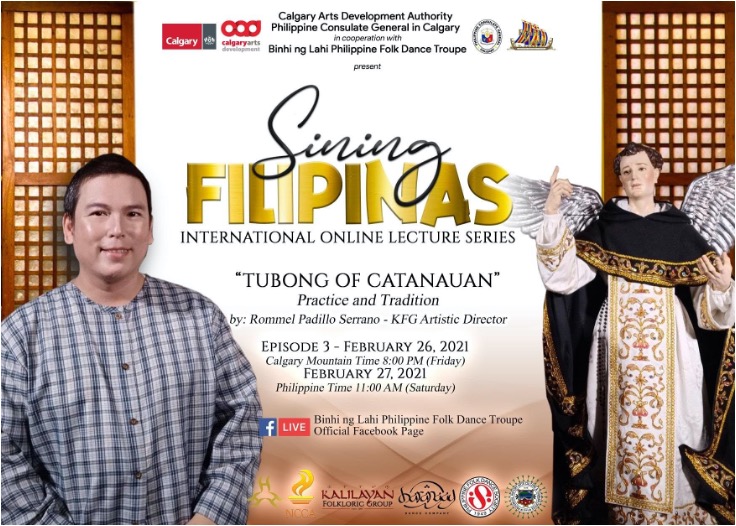
4 March 2021, Calgary – Another edition of the online lecture series on Philippine arts dubbed “Sining Filipinas” aired live on the night of 26 February 2021, Calgary time, at the Facebook page of Binhi ng Lahi Philippine Folk Dance Troupe (Binhi). It is the series’ third episode entitled “Tubong of Catanauan: Practice and Tradition” with Mr. Rommel Padillo Serrano, Artistic Director of Kalilayan Folkloric Group (KFG) of Catanauan, Quezon, as the lecturer.
The tubong dance ritual of Catanauan is a tradition believed to have come down from Marinduque’s putong or putungan, the popular crowning ritual originally accorded to birthday celebrants, to those who just recovered from a serious illness, someone returning after a long absence, or of late, to greet esteemed visitors.
Catanauan’s tubong, practiced by migrant families from Marinduque who settled in Brgy. San Vicente Kanluran, is held with the intention of wishing the birthday celebrant good health through the intercession of San Vicente Ferrer, the patron saint of the sick. It is one grand treat to the celebrant or honoree as it involves singing, dancing, gift-giving, showering of flowers, drink and food feast, and the essential crowning ceremony.
Catanauan’s version of the tubong, which was documented by Mr. Serrano during his early forays to document the dance traditions of his hometown back in 2006, was one involving a girl celebrating her seventh birthday.
In the 2007 Cultural Center of the Philippines (CCP) production “Sari-saring Sayaw, Sama-samang Galaw,” Mr. Serrano distilled the four-hour long tubong ritual into its five-minute stage-adapted form with choreography based on documented dance movements, accompanied by an abridged tubong song. It highlighted the song and danced portions of the ritual and was first performed on the CCP production by the original tubong performers from San Vicente Kanluran performing alongside KFG dancers, singers and musicians. The tubong song-dance was later presented in the Philippine Folk Dance Society’s 2017 national folk dance workshop in Dumaguete City.
The lecture concentrated on the song and danced portions of the ritual which in its original ritual performance context are usually interspersed with the vital portions of the tubong, such as the grand entrance of the celebrant, the paso of male attendees, the offering of gifts, pinning of money, the community dance, and the pag-iipon.
The part where the community dances, brought to fore a showcase of dance steps or movements unique to the Catanauan folks such the two versions of binanog – one executed with picturesque shoulder flaps said to imitate the banog (hawk), and the second one looking like a hawk’s diagonal wingspread soar with graceful kumintang wrist twists while doing quarter turns. There is also the balse Catanauanin – a distinct waltz step with the torso twisted left and right while the head is fixed facing front, and the paso step which could also be executed with an accented close step or close stamp moving forward or sideward.
The episode is another culturally enriching learning session as it provided not only a new dance and song learned, but more so for putting into the limelight a seldom seen, if not nearly vanishing tradition that was successfully documented and revitalized, albeit in its adoptive form. Dance enthusiasts and dance troupes in Canada, the Philippines, and in Filipino communities in the diaspora could benefit from this song-dance. It also gave a detailed account on a slice of the worldview of the Tagalog people of the Quezon-Marinduque area, and the interesting dynamics of their distinct yet similar cultures.
The Philippine Consulate General in Calgary and the Calgary Arts Development Authority, City of Calgary are the major sponsors “Sining Filipinas.” Culture and arts institutions in both the government and the private sectors have also partnered with Binhi to realize this culturally enriching lecture series – the National Commission for Culture and the Arts (NCCA), Cultural Center of the Philippines (CCP), Philippine Folk Dance Society (PFDS), Provincial History, Arts, Culture and Tourism Office (PHASCO) of the Province of Bulacan, Barangay Dance Company (PBDC) of San Francisco, California – USA; and the Kalilayan Folkloric Group (KFG) of Catanauan, Quezon.
